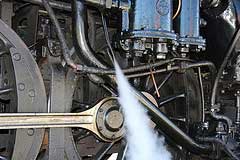Writers choose words for the layers of meaning they carry and for the feelings and emotions they evoke. This is why denotative meaning and connotative meaning are important to understand. A word’s denotation is its literal, dictionary definition. A word’s connotation involves the emotional associations that the word brings to mind. It is important to consider both denotation and connotation when you read because they contain the meanings of words. As you may have noticed, an author’s decision to choose one word over another can change the entire tone of a reading passage. This is why diction is such a powerful tool!

Source: Steam Locomotive Ja 1260, joinash, flickr
Let’s look at this sentence again:
She looked at me, her eyes darkening with rage, and hissed,
“Save it.”
Notice the word “hissed.” Why do you think the writer chose “hissed” instead of “uttered” or “said”? Snakes hiss and steam engines hiss. How is a snake's hissing different from a steam engine's? Which image seems most fitting for this sentence: Does it sound like the woman is letting off steam or threatening someone?
Sample Response:
The words “eyes darkening with rage” give the reader a clue that the woman is very angry and that she’s threatening someone.
Now try working with denotation and connotation on your own. From the word list on the right, drag and drop each connotative meaning next to its matching denotative meaning on the left.
![]()
If you want to practice more with denotation and connotation, go to the related resource titled “Denotation and Connotation.”